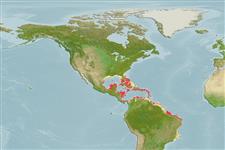>
Eupercaria/misc (Various families in series Eupercaria) >
Haemulidae (Grunts) > Haemulinae
Etymology: Haemulon: Greek, haimaleos = bloody (Ref. 45335).
Environment: milieu / climate zone / Tiefenbereich / distribution range
Ökologie
seewasser riff-verbunden; ozeanodrom (Ref. 51243); tiefenbereich 3 - 30 m (Ref. 9626). Subtropical; 31°N - 30°S, 98°W - 34°W
Western Atlantic: Bahamas, Florida (USA), and northern Gulf of Mexico to Brazil.
Size / Gewicht / Alter
Geschlechtsreife: Lm ? range ? - ? cm
Max length : 41.2 cm TL Männchen/unbestimmt; (Ref. 9626); common length : 30.0 cm TL Männchen/unbestimmt; (Ref. 3798)
Rückenflossenstacheln (insgesamt) : 12; Rückenflossenweichstrahlen (insgesamt) : 16 - 18; Afterflossenstacheln: 3; Afterflossenweichstrahlen: 8. Silvery, the edges of the scales narrowly brown, the centers on upper half of body with a spot which may vary in color from yellow through bronze to dark brown (forming oblique dotted lines following scale rows) (Ref. 13442).
Body shape (shape guide): short and / or deep.
Inhabits shallow coastal reefs, the young on seagrass beds, adults in schools in relatively open areas (Ref. 9710). Rare at oceanic islands (Ref. 9710). Feeds at night on mollusks and small fishes (Ref. 9710). Marketed fresh (Ref. 3798).
Life cycle and mating behavior
Geschlechtsreife | Fortpflanzung | Ablaichen | Eier | Fecundity | Larven
Oviparous, distinct pairing during breeding (Ref. 205).
Robins, C.R. and G.C. Ray, 1986. A field guide to Atlantic coast fishes of North America. Houghton Mifflin Company, Boston, U.S.A. 354 p. (Ref. 7251)
IUCN Rote Liste Status (Ref. 130435: Version 2025-1)
Bedrohung für Menschen
Harmless
Nutzung durch Menschen
Fischereien: weniger kommerziell; Sportfisch: ja; Aquarium: Öffentliche Aquarien
Tools
Zusatzinformationen
Download XML
Internet Quellen
Estimates based on models
Preferred temperature (Ref.
123201): 25.6 - 28.2, mean 27.4 °C (based on 724 cells).
Phylogenetic diversity index (Ref.
82804): PD
50 = 0.5000 [Uniqueness, from 0.5 = low to 2.0 = high].
Bayesian length-weight: a=0.01318 (0.00824 - 0.02108), b=3.01 (2.88 - 3.14), in cm total length, based on LWR estimates for this species & Genus-body shape (Ref.
93245).
Trophic level (Ref.
69278): 3.5 ±0.2 se; based on diet studies.
Generation time: 4.6 ( na - na) years. Estimated as median ln(3)/K based on 1
growth studies.
Widerstandsfähigkeit (Ref.
120179): mittel, Verdopplung der Population dauert 1,4 - 4,4 Jahre. (K=0.24).
Fishing Vulnerability (Ref.
59153): Moderate vulnerability (37 of 100).
🛈
Nutrients (Ref.
124155): Calcium = 21.8 [9.8, 59.1] mg/100g; Iron = 0.531 [0.258, 1.032] mg/100g; Protein = 19.6 [17.6, 21.6] %; Omega3 = 0.148 [0.067, 0.287] g/100g; Selenium = 14.3 [6.4, 29.5] μg/100g; VitaminA = 34.6 [9.2, 127.5] μg/100g; Zinc = 0.681 [0.413, 1.102] mg/100g (wet weight);
